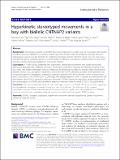Hyperkinetic stereotyped movements in a boy with biallelic CNTNAP2 variants
Abstract
Background: Heterozygous variants in CNTNAP2 have been implicated in a wide range of neurological phenotypes, including intellectual disability (ID), epilepsy, autistic spectrum disorder (ASD), and impaired language. However, heterozygous variants can also be found in unaffected individuals. Biallelic CNTNAP2 variants are rarer and cause a well-defined genetic syndrome known as CASPR2 deficiency disorder, a condition characterised by ID, early-onset refractory epilepsy, language impairment, and autistic features. Case-report : A 7-year-old boy presented with hyperkinetic stereotyped movements that started during early infancy and persisted over childhood. Abnormal movements consisted of rhythmic and repetitive shaking of the four limbs, with evident stereotypic features. Additional clinical features included ID, attention deficit-hyperactivity disorder (ADHD), ASD, and speech impairment, consistent with CASPR2 deficiency disorder. Whole-genome array comparative genomic hybridization detected a maternally inherited 0.402 Mb duplication, which involved intron 1, exon 2, and intron 2 of CNTNAP2 (c.97 +?_209-?dup). The affected region in intron 1 contains a binding site for the transcription factor FOXP2, potentially leading to abnormal CNTNAP2 expression regulation. Sanger sequencing of the coding region of CNTNAP2 also identified a paternally-inherited missense variant c.2752C > T, p.(Leu918Phe). Conclusion : This case expands the molecular and phenotypic spectrum of CASPR2 deficiency disorder, suggesting that Hyperkinetic stereotyped movements may be a rare, yet significant, clinical feature of this complex neurological disorder. Furthermore, the identification of an in-frame, largely non-coding duplication in CNTNAP2 points to a sophisticated underlying molecular mechanism, likely involving impaired FOXP2 binding.
Citation
Scala , M , Anijs , M , Battini , R , Madia , F , Capra , V , Scudieri , P , Verrotti , A , Zara , F , Minetti , C , Vernes , S C & Striano , P 2021 , ' Hyperkinetic stereotyped movements in a boy with biallelic CNTNAP2 variants ' , Italian Journal of Pediatrics , vol. 47 , 208 . https://doi.org/10.1186/s13052-021-01162-w
Publication
Italian Journal of Pediatrics
Status
Peer reviewed
ISSN
1824-7288Type
Journal article
Description
SCV was supported by a Max Planck Research Group awarded by the Max Planck Gesellschaft, a Human Frontiers Science Program Grant (RGP0058/2016), and a UKRI Future Leaders Fellowship (MR/T021985/1). MA was supported by an International Max Planck Research School (IMPRS) PhD Fellowship from the Max Planck Institute for Psycholinguistics.Collections
Items in the St Andrews Research Repository are protected by copyright, with all rights reserved, unless otherwise indicated.

